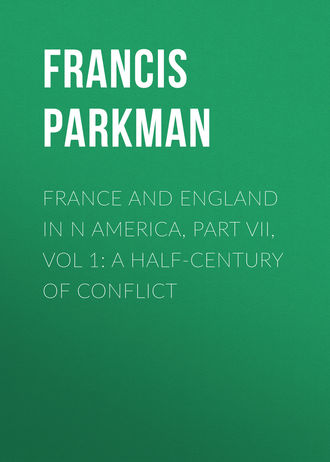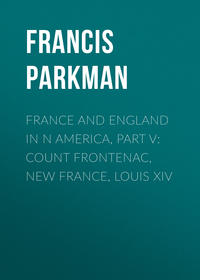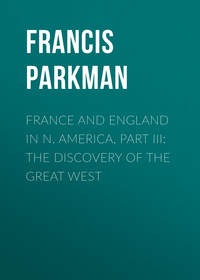 полная версия
полная версияFrance and England in N America, Part VII, Vol 1: A Half-Century of Conflict
Scarcely a hamlet of the Massachusetts and New Hampshire borders escaped a visit from the nimble enemy. Groton, Lancaster, Exeter, Dover, Kittery, Casco, Kingston, York, Berwick, Wells, Winter Harbor, Brookfield, Amesbury, Marlborough, were all more or less infested, usually by small scalping-parties, hiding in the outskirts, waylaying stragglers, or shooting men at work in the fields, and disappearing as soon as their blow was struck. These swift and intangible persecutors were found a far surer and more effectual means of annoyance than larger bodies. As all the warriors were converts of the Canadian missions, and as prisoners were an article of value, cases of torture were not very common; though now and then, as at Exeter, they would roast some poor wretch alive, or bite off his fingers and sear the stumps with red-hot tobacco pipes.
This system of petty, secret, and transient attack put the impoverished colonies to an immense charge in maintaining a cordon of militia along their northern frontier,—a precaution often as vain as it was costly; for the wily savages, covered by the forest, found little difficulty in dodging the scouting-parties, pouncing on their victims, and escaping. Rewards were offered for scalps; but one writer calculates that, all things considered, it cost Massachusetts a thousand pounds of her currency to kill an Indian.80
In 1703-1704 six hundred men were kept ranging the woods all winter without finding a single Indian, the enemy having deserted their usual haunts and sought refuge with the French, to emerge in February for the destruction of Deerfield. In the next summer nineteen hundred men were posted along two hundred miles of frontier.81 This attitude of passive defence exasperated the young men of Massachusetts, and it is said that five hundred of them begged Dudley for leave to make a raid into Canada, on the characteristic condition of choosing their own officers. The governor consented; but on a message from Peter Schuyler that he had at last got a promise from the Caughnawagas and other mission Indians to attack the New England borders no more, the raid was countermanded, lest it should waken the tempest anew.82
What was the object of these murderous attacks, which stung the enemy without disabling him, confirmed the Indians in their native savagery, and taught the French to emulate it? In the time of Frontenac there was a palliating motive for such barbarous warfare. Canada was then prostrate and stunned under the blows of the Iroquois war. Successful war-parties were needed as a tonic and a stimulant to rouse the dashed spirits of French and Indians alike; but the remedy was a dangerous one, and it drew upon the colony the attack under Sir William Phips, which was near proving its ruin. At present there was no such pressing call for butchering women, children, and peaceful farmers. The motive, such as it was, lay in the fear that the Indian allies of France might pass over to the English, or at least stand neutral. These allies were the Christian savages of the missions, who, all told, from the Caughnawagas to the Micmacs, could hardly have mustered a thousand warriors. The danger was that the Caughnawagas, always open to influence from Albany, might be induced to lay down the hatchet and persuade the rest to follow their example. Therefore, as there was for the time a virtual truce with New York, no pains were spared to commit them irrevocably to war against New England. With the Abenaki tribes of Maine and New Hampshire the need was still more urgent, for they were continually drawn to New England by the cheapness and excellence of English goods; and the only sure means to prevent their trading with the enemy was to incite them to kill him. Some of these savages had been settled in Canada, to keep them under influence and out of temptation; but the rest were still in their native haunts, where it was thought best to keep them well watched by their missionaries, as sentinels and outposts to the colony.
There were those among the French to whom this barbarous warfare was repugnant. The minister, Ponchartrain, by no means a person of tender scruples, also condemned it for a time. After the attack on Wells and other places under Beaubassin in 1703, he wrote: "It would have been well if this expedition had not taken place. I have certain knowledge that the English want only peace, knowing that war is contrary to the interests of all the colonies. Hostilities in Canada have always been begun by the French."83 Afterwards, when these bloody raids had produced their natural effect and spurred the sufferers to attempt the ending of their woes once for all by the conquest of Canada, Ponchartrain changed his mind and encouraged the sending out of war-parties, to keep the English busy at home.
The schemes of a radical cure date from the attack on Deerfield and the murders of the following summer. In the autumn we find Governor Dudley urging the capture of Quebec. "In the last two years," he says, "the Assembly of Massachusetts has spent about £50,000 in defending the Province, whereas three or four of the Queen's ships and fifteen hundred New England men would rid us of the French and make further outlay needless,"—a view, it must be admitted, sufficiently sanguine.84
But before seeking peace with the sword, Dudley tried less strenuous methods. It may be remembered that in 1705 Captain Vetch and Samuel Hill, together with the governor's young son William, went to Quebec to procure an exchange of prisoners. Their mission had also another object. Vetch carried a letter from Dudley to Vaudreuil, proposing a treaty of neutrality between their respective colonies, and Vaudreuil seems to have welcomed the proposal. Notwithstanding the pacific relations between Canada and New York, he was in constant fear that Dutch and English influence might turn the Five Nations into open enemies of the French; and he therefore declared himself ready to accept the proposals of Dudley, on condition that New York and the other English colonies should be included in the treaty, and that the English should be excluded from fishing in the Gulf of St. Lawrence and the Acadian seas. The first condition was difficult, and the second impracticable; for nothing could have induced the people of New England to accept it. Vaudreuil, moreover, would not promise to give up prisoners in the hands of the Indians, but only to do what he could to persuade their owners to give them up. The negotiations dragged on for several years. For the first three or four months Vaudreuil stopped his war-parties; but he let them loose again in the spring, and the New England borders were tormented as before.
The French governor thought that the New England country people, who had to bear the brunt of the war, were ready to accept his terms. The French court approved the plan, though not without distrust; for some enemy of the governor told Ponchartrain that under pretence of negotiations he and Dudley were carrying on trading speculations,—which is certainly a baseless slander.85 Vaudreuil on his part had strongly suspected Dudley's emissary, Vetch, of illicit trade during his visit to Quebec; and perhaps there was ground for the suspicion. It is certain that Vetch, who had visited the St. Lawrence before, lost no opportunity of studying the river, and looked forward to a time when he could turn his knowledge to practical account.86
Joseph Dudley, governor of Massachusetts and New Hampshire, was the son of a former governor of Massachusetts,—that upright, sturdy, narrow, bigoted old Puritan, Thomas Dudley, in whose pocket was found after his death the notable couplet,—
"Let men of God in courts and churches watchO'er such as do a toleration hatch."Such a son of such a father was the marvel of New England. Those who clung to the old traditions and mourned for the old theocracy under the old charter, hated Joseph Dudley as a renegade; and the worshippers of the Puritans have not forgiven him to this day. He had been president of the council under the detested Andros, and when that representative of the Stuarts was overthrown by a popular revolution, both he and Dudley were sent prisoners to England. Here they found a reception different from the expectations and wishes of those who sent them. Dudley became a member of Parliament and lieutenant-governor of the Isle of Wight, and was at length, in the beginning of the reign of Queen Anne, sent back to govern those who had cast him out. Any governor imposed on them by England would have been an offence; but Joseph Dudley was more than they could bear.
He found bitter opposition from the old Puritan party. The two Mathers, father and son, who through policy had at first favored him, soon denounced him with insolent malignity, and the honest and conscientious Samuel Sewall regarded him with as much asperity as his kindly nature would permit. To the party of religious and political independency he was an abomination, and great efforts were made to get him recalled. Two pamphlets of the time, one printed in 1707 and the other in the next year, reflect the bitter animosity he excited.87 Both seem to be the work of several persons, one of whom, there can be little doubt, was Cotton Mather; for it is not easy to mistake the mingled flippancy and pedantry of his style. He bore the governor a grudge, for Dudley had chafed him in his inordinate vanity and love of power.
If Dudley loved himself first, he loved his native New England next, and was glad to serve her if he could do so in his own way and without too much sacrifice of his own interests. He was possessed by a restless ambition, apparently of the cheap kind that prefers the first place in a small community to the second in a large one. He was skilled in the arts of the politician, and knew how, by attentions, dinners, or commissions in the militia, to influence his Council and Assembly to do his will. His abilities were beyond question, and his manners easy and graceful; but his instincts were arbitrary. He stood fast for prerogative, and even his hereditary Calvinism had strong Episcopal leanings. He was a man of the world in the better as well as the worse sense of the term; was loved and admired by some as much as he was hated by others; and in the words of one of his successors, "had as many virtues as can consist with so great a thirst for honor and power."88
His enemies, however, set no bounds to their denunciation. "All the people here are bought and sold betwixt the governour and his son Paul," says one. "It is my belief," says another, probably Cotton Mather, "that he means to help the French and Indians to destroy all they can." And again, "He is a criminal governour.... His God is Mammon, his aim is the ruin of his country." The meagreness and uncertainty of his salary, which was granted by yearly votes of the Assembly, gave color to the charge that he abused his official position to improve his income. The worst accusation against him was that of conniving in trade with the French and Indians under pretence of exchanging prisoners. Six prominent men of the colony—Borland, Vetch, Lawson, Rous, Phillips, and Coffin, only three of whom were of New England origin—were brought to trial before the Assembly for trading at Port Royal; and it was said that Dudley, though he had no direct share in the business, found means to make profit from it. All the accused were convicted and fined. The more strenuous of their judges were for sending them to jail, and Rous was to have been sentenced to "sit an hour upon the gallows with a rope about his neck;" but the governor and council objected to these severities, and the Assembly forbore to impose them. The popular indignation against the accused was extreme, and probably not without cause.89 There was no doubt an illicit trade between Boston and the French of Acadia, who during the war often depended on their enemies for the necessaries of life, since supplies from France, precarious at the best, were made doubly so by New England cruisers. Thus the Acadians and their Indian allies were but too happy to exchange their furs for very modest supplies of tools, utensils, and perhaps, at times, of arms, powder, and lead.90 What with privateering and illicit trade, it was clear that the war was a source of profit to some of the chief persons in Boston. That place, moreover, felt itself tolerably safe from attack, while the borders were stung from end to end as by a swarm of wasps; and thus the country conceived the idea that the town was fattening at its expense. Vaudreuil reports to the minister that the people of New England want to avenge themselves by an attack on Canada, but that their chief men are for a policy of defence. This was far from being wholly true; but the notion that the rural population bore a grudge against Boston had taken strong hold of the French, who even believed that if the town were attacked, the country would not move hand or foot to help it. Perhaps it was well for them that they did not act on the belief, which, as afterwards appeared, was one of their many mistakes touching the character and disposition of their English neighbors.
The sentences on Borland and his five companions were annulled by the Queen and Council, on the ground that the Assembly was not competent to try the case.91 The passionate charges against Dudley and a petition to the Queen for his removal were equally unavailing. The Assemblies of Massachusetts and New Hampshire, the chief merchants, the officers of militia, and many of the ministers sent addresses to the Queen in praise of the governor's administration;92 and though his enemies declared that the votes and signatures were obtained by the arts familiar to him, his recall was prevented, and he held his office seven years longer.
CHAPTER VI
1700-1710THE OLD RÉGIME IN ACADIAThe Fishery Question.—Privateers and Pirates.—Port Royal.—Official Gossip.—Abuse of Brouillan.—Complaints of De Goutin.—Subercase and his Officers.—Church and State.—Paternal Government.
The French province of Acadia, answering to the present Nova Scotia and New Brunswick, was a government separate from Canada and subordinate to it. Jacques François de Brouillan, appointed to command it, landed at Chibucto, the site of Halifax, in 1702, and crossed by hills and forests to the Basin of Mines, where he found a small but prosperous settlement. "It seems to me," he wrote to the minister, "that these people live like true republicans, acknowledging neither royal authority nor courts of law."93 It was merely that their remoteness and isolation made them independent, of necessity, so far as concerned temporal government. When Brouillan reached Port Royal he found a different state of things. The fort and garrison were in bad condition; but the adjacent settlement, primitive as it was, appeared on the whole duly submissive.
Possibly it would have been less so if it had been more prosperous; but the inhabitants had lately been deprived of fishing, their best resource, by a New England privateer which had driven their craft from the neighboring seas; and when the governor sent Lieutenant Neuvillette in an armed vessel to seize the interloping stranger, a fight ensued, in which the lieutenant was killed, and his vessel captured. New England is said to have had no less than three hundred vessels every year in these waters.94 Before the war a French officer proposed that New England sailors should be hired to teach the Acadians how to fish, and the King seems to have approved the plan.95 Whether it was adopted or not, New England in peace or war had a lion's share of the Acadian fisheries. "It grieves me to the heart," writes Subercase, Brouillan's successor, "to see Messieurs les Bastonnais enrich themselves in our domain; for the base of their commerce is the fish which they catch off our coasts, and send to all parts of the world."
When the war broke out, Brouillan's fighting resources were so small that he was forced to depend largely for help on sea-rovers of more than doubtful character. They came chiefly from the West Indies,—the old haunt of buccaneers,—and were sometimes mere pirates, and sometimes semi-piratical privateers commissioned by French West Indian governors. Brouillan's successor writes that their opportunities are good, since at least a thousand vessels enter Boston every year.96 Besides these irregular allies, the governor usually had at his disposal two French frigates of thirty and sixty guns, to which was opposed the Massachusetts navy, consisting of a ship of fifty-six guns, and the "province galley," of twenty-two. In 1710 one of these Massachusetts vessels appeared off the coast escorting a fishing-fleet of no less than two hundred and fifty sail, some of which were afterwards captured by French corsairs. A good number of these last, however, were taken from time to time by Boston sea-rovers, who, like their enemies, sometimes bore a close likeness to pirates. They seized French fishing and trading vessels, attacked French corsairs, sometimes traded with the Acadians, and sometimes plundered them. What with West India rum brought by the French freebooters, and New England rum brought by the English, it is reported that one could get drunk in Acadia for two sous.
Port Royal, now Annapolis, was the seat of government, and the only place of any strength in the colony. The fort, a sodded earthwork, lately put into tolerable repair by the joint labor of the soldiers and inhabitants, stood on the point of land between the mouth of the river Annapolis and that of the small stream now called Allen's River, whence it looked down the long basin, or land-locked bay, which, framed in hills and forests, had so won the heart of the Baron de Poutrincourt a century before.97 The garrison was small, counting in 1704 only a hundred and eighty-five soldiers and eight commissioned officers. At the right of the fort, between it and the mouth of the Annapolis, was the Acadian village, consisting of seventy or eighty small houses of one story and an attic, built of planks, boards, or logs, simple and rude, but tolerably comfortable. It had also a small, new wooden church, to the building of which the inhabitants had contributed eight hundred francs, while the King paid the rest. The inhabitants had no voice whatever in public affairs, though the colonial minister had granted them the privilege of travelling in time of peace without passports. The ruling class, civil and military, formed a group apart, living in or near the fort, in complete independence of public opinion, supposing such to have existed. They looked only to their masters at Versailles; and hence a state of things as curious as it was lamentable. The little settlement was a hot-bed of gossip, backbiting, and slander. Officials of every degree were continually trying to undermine and supplant one another, besieging the minister with mutual charges. Brouillan, the governor, was a frequent object of attack. He seems to have been of an irritable temper, aggravated perhaps by an old unhealed wound in the cheek, which gave him constant annoyance. One writer declares that Acadia languishes under selfish greed and petty tyranny; that everything was hoped from Brouillan when he first came, but that hope has changed to despair; that he abuses the King's authority to make money, sells wine and brandy at retail, quarrels with officers who are not punctilious enough in saluting him, forces the inhabitants to catch seal and cod for the King, and then cheats them of their pay, and countenances an obnoxious churchwarden whose daughter is his mistress. "The country groans, but dares not utter a word," concludes the accuser, as he closes his indictment.98
Brouillan died in the autumn of 1705, on which M. de Goutin, a magistrate who acted as intendant, and was therefore at once the colleague of the late governor and a spy upon him, writes to the minister that "the divine justice has at last taken pity on the good people of this country," but that as it is base to accuse a dead man, he will not say that the public could not help showing their joy at the late governor's departure; and he adds that the deceased was charged with a scandalous connection with the Widow de Freneuse. Nor will he reply, he says, to the governor's complaint to the court about a pretended cabal, of which he, De Goutin, was the head, and which was in reality only three or four honest men, incapable of any kind of deviation, who used to meet in a friendly way, and had given offence by not bowing down before the beast.99
Then he changes the subject, and goes on to say that on a certain festal occasion he was invited by Bonaventure, who acted as governor after the death of Brouillan, to share with him the honor of touching off a bonfire before the fort gate; and that this excited such envy, jealousy, and discord that he begs the minister, once for all, to settle the question whether a first magistrate has not the right to the honor of touching off a bonfire jointly with a governor.
De Goutin sometimes discourses of more serious matters. He tells the minister that the inhabitants have plenty of cattle, and more hemp than they can use, but neither pots, scythes, sickles, knives, hatchets, kettles for the Indians, nor salt for themselves. "We should be fortunate if our enemies would continue to supply our necessities and take the beaver-skins with which the colony is gorged;" adding, however, that the Acadians hate the English, and will not trade with them if they can help it.100
In the next year the "Bastonnais" were again bringing supplies, and the Acadians again receiving them. The new governor, Subercase, far from being pleased at this, was much annoyed, or professed to be so, and wrote to Ponchartrain, "Nobody could suffer more than I do at seeing the English so coolly carry on their trade under our very noses." Then he proceeds to the inevitable personalities. "You wish me to write without reserve of the officers here; I have little good to tell you;" and he names two who to the best of his belief have lost their wits, a third who is incorrigibly lazy, and a fourth who is eccentric; adding that he is tolerably well satisfied with the rest, except M. de la Ronde. "You see, Monseigneur, that I am as much in need of a madhouse as of barracks; and what is worse, I am afraid that the mauvais esprit of this country will drive me crazy too."101 "You write to me," he continues, "that you are informed that M. Labat has killed some cattle belonging to the inhabitants. If so, he has expiated his fault by blowing off his thumb by the bursting of his gun while he was firing at a sheep. I am sure that the moon has a good deal to do with his behavior; he always acts very strangely when she is on the wane."
The charge brought against Brouillan in regard to Madame de Freneuse was brought also against Bonaventure in connection with the same lady. "The story," says Subercase, "was pushed as far as hell could desire;"102 and he partially defends the accused, declaring that at least his fidelity to the King is beyond question.
De Goutin had a quarrel with Subercase, and writes: "I do all that is possible to live on good terms with him, and to that end I walk as if in the chamber of a sick prince whose sleep is of the lightest." As Subercase defends Bonaventure, De Goutin attacks him, and gives particulars concerning him and Madame de Freneuse which need not be recounted here. Then comes a story about a quarrel caused by some cows belonging to Madame de Freneuse which got into the garden of Madame de Saint-Vincent, and were driven out by a soldier who presumed to strike one of them with a long stick. "The facts," gravely adds De Goutin, "have been certified to me as I have the honor to relate them to your Grandeur."103 Then the minister is treated to a story of one Allein. "He insulted Madame de Belleisle at the church door after high mass, and when her son, a boy of fourteen, interposed, Allein gave him such a box on the ear that it drew blood; and I am assured that M. Petit, the priest, ran to the rescue in his sacerdotal robes." Subercase, on his side, after complaining that the price of a certain canoe had been unjustly deducted from his pay, though he never had the said canoe at all, protests to Ponchartrain, "there is no country on earth where I would not rather live than in this, by reason of the ill-disposed persons who inhabit it."104
There was the usual friction between the temporal and the spiritual powers. "The Church," writes Subercase, "has long claimed the right of commanding here, or at least of sharing authority with the civil rulers."105 The Church had formerly been represented by the Capuchin friars, and afterwards by the Récollets. Every complaint was of course carried to the minister. In 1700 we find M. de Villieu, who then held a provisional command in the colony, accusing the ecclesiastics of illicit trade with the English.106 Bonaventure reports to Ponchartrain that Père Félix, chaplain of the fort, asked that the gate might be opened, in order that he might carry the sacraments to a sick man, his real object being to marry Captain Duvivier to a young woman named Marie Muis de Poubomcoup,—contrary, as the governor thought, to the good of the service. He therefore forbade the match; on which the priests told him that when they had made up their minds to do anything, nobody had power to turn them from it; and the chaplain presently added that he cared no more for the governor than for the mud on his shoes.107 He carried his point, and married Duvivier in spite of the commander.







